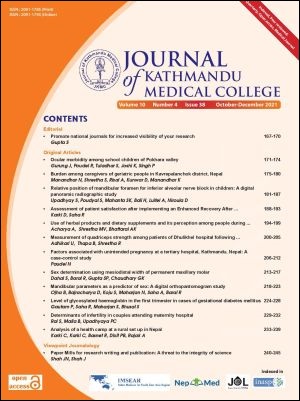Factors associated with unintended pregnancy at a tertiary hospital, Kathmandu, Nepal: A case-control study
DOI:
https://doi.org/10.3126/jkmc.v10i4.43855Keywords:
Case control study, Nepal, Tertiary hospital, Unintended pregnancyAbstract
Background: Despite the widely available family planning efforts to reduce the proportion of unwanted pregnancies, the rate of unintended pregnancies is still significantly large in Nepal.
Objectives: To find out the factors associated with unintended pregnancy.
Methods: A case-control study was conducted in Kathmandu Medical College Teaching Hospital. Cases were the women seeking safe abortion services for unintended pregnancy and women with intended pregnancy were controls. Eightyone cases and eighty-one controls (total 162 women) were included in the study purposively. Face-to-face interview was done to collect data using structured questionnaire. Data were collected from 15th January 2019 to 30th August 2019. Ethical clearance was obtained from institutional review committee of Kathmandu Medical College. Permission for data collection was obtained from the head of the department of Obstetrics and Gynaecology and written informed consent was taken from each respondent. Data were analysed using statistical package for social sciences 20.0 version.
Results: Age below 20 years (AOR: 5.14; 95% CI: 1.14, 23.06) and above 30 years (AOR: 2.59; 95% CI: 1.10, 6.08); primary level education (AOR: 4.46; 95% CI: 1.27, 15.62); and secondary level education (AOR: 2.97; CI: 1.39, 6.34), student by occupation (AOR: 11.40; 95% CI: 3.07, 42.25), three and more gravidity (AOR: 13.82; 95% CI: 4.56, 41.87)) and perceived ideal number of child one (AOR: 4.63; 95% CI: 1.18, 18.10) were associated with increased risk of unintended pregnancy.
Conclusion: Age, education, occupation, gravidity, and perceived ideal number of children were the factors significantly associated with unintended pregnancy.
Downloads
Downloads
Published
How to Cite
Issue
Section
License
Copyright © Journal of Kathmandu Medical College
The ideas and opinions expressed by authors or articles summarized, quoted, or published in full text in this journal represent only the opinions of the authors and do not necessarily reflect the official policy of Journal of Kathmandu Medical College or the institute with which the author(s) is/are affiliated, unless so specified.
Authors convey all copyright ownership, including any and all rights incidental thereto, exclusively to JKMC, in the event that such work is published by JKMC. JKMC shall own the work, including 1) copyright; 2) the right to grant permission to republish the article in whole or in part, with or without fee; 3) the right to produce preprints or reprints and translate into languages other than English for sale or free distribution; and 4) the right to republish the work in a collection of articles in any other mechanical or electronic format.




